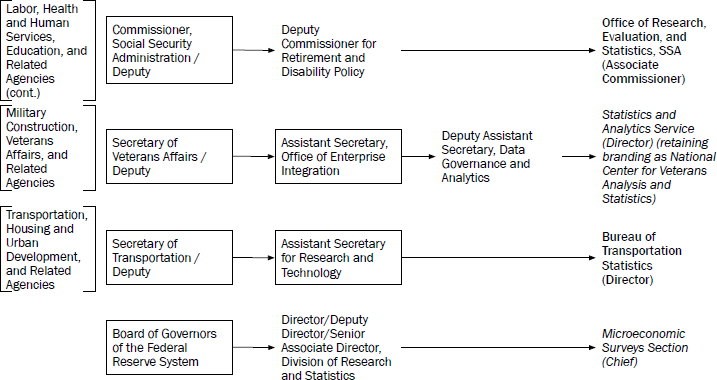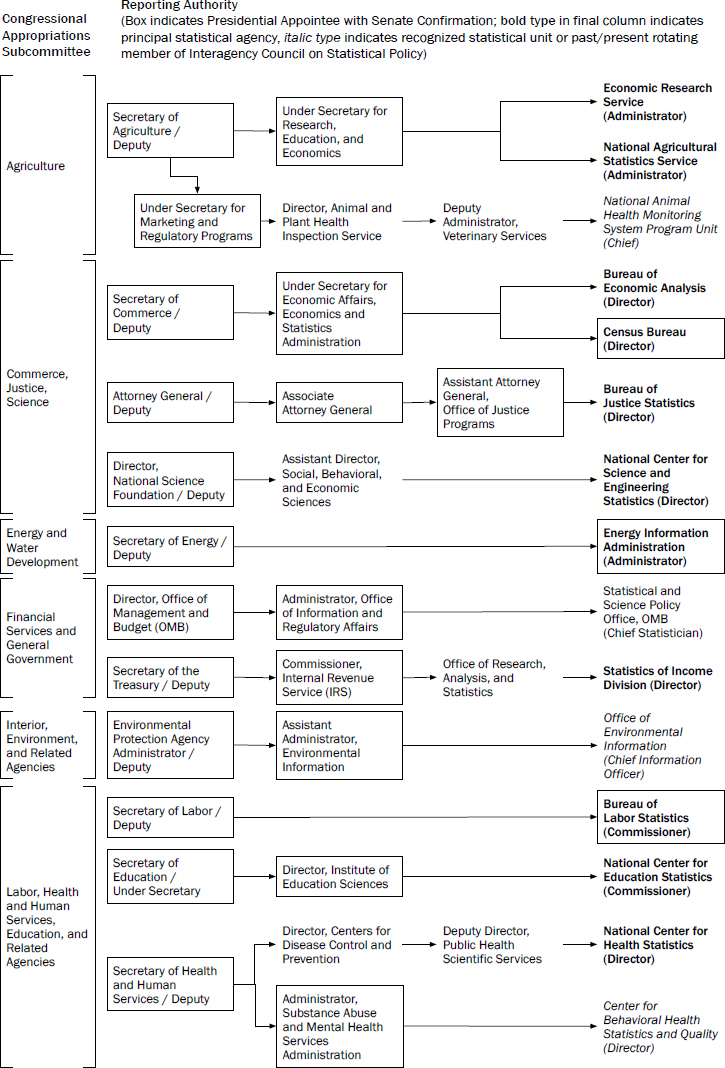Brief History of the U.S. Federal Statistical System
THE U.S. GOVERNMENT COLLECTED AND PUBLISHED statistics long before any distinct federal statistical agency was formed (see Appendix B; see also Anderson, 2015; Citro, 2016; Duncan and Shelton, 1978; Norwood, 1995). The U.S. Constitution mandated a decennial census of population; the first such censuses (beginning in 1790) were conducted by U.S. marshals as one of their many duties. The Constitution also mandated reporting of federal government receipts and expenditures, which led to early collection by the U.S. Department of the Treasury of foreign trade statistics because of the reliance of the federal government on tariffs for revenues in the 19th century. A census of manufactures was first taken in conjunction with the 1810 population census, and the 1820 population census laid the groundwork for additional economic statistics by asking for the number of household members principally employed in agriculture, manufacturing, or commerce.
In the 1860s, Congress enacted laws providing for the compilation of statistics on agriculture, education, and income. It established the Bureau of Labor (forerunner of the Bureau of Labor Statistics) as a separate agency with a mandate to respond to widespread public demand for information on the conditions of industrial workers in 1884. It established the Census Bureau as a permanent agency in 1902.
Many federal statistical agencies that can trace their roots back to the 19th or early 20th century, such as the Bureau of Economic Analysis and the National Center for Health Statistics, were organized in their current form following World War II. Agencies organized since then include the Bureau of Justice Statistics, the Bureau of Transportation Statistics, the
Energy Information Administration, and the National Center for Science and Engineering Statistics.
Today, the U.S. Office of Management and Budget (OMB), through its Statistical and Science Policy Office (which has roots going back to the 1930s), coordinates the work of federal statistical agencies. The chief statistician, who heads the office, chairs the Interagency Council on Statistical Policy (ICSP), which was created by OMB in the late 1980s and authorized in statute in 1995. The current ICSP membership includes the heads of the 13 principal statistical agencies17 and one other agency:18
- Bureau of Economic Analysis (U.S. Department of Commerce)
- Bureau of Justice Statistics (U.S. Department of Justice)
- Bureau of Labor Statistics (U.S. Department of Labor)
- Bureau of Transportation Statistics (U.S. Department of Transportation)
- Census Bureau (U.S. Department of Commerce)
- Economic Research Service (U.S. Department of Agriculture)
- Energy Information Administration (U.S. Department of Energy)
- National Agricultural Statistics Service (U.S. Department of Agriculture)
- National Center for Education Statistics (U.S. Department of Education)
- National Center for Health Statistics (U.S. Department of Health and Human Services)
- National Center for Science and Engineering Statistics (U.S. National Science Foundation)
- National Center for Veterans Analysis and Statistics (NCVAS) (U.S. Department of Veterans Affairs)
- Office of Research, Evaluation, and Statistics (U.S. Social Security Administration)
- Statistics of Income Division (U.S. Department of the Treasury)
Under the guidance issued in 2007 for the Confidential Information Protection and Statistical Efficiency Act of 2002 (CIPSEA) (see Appendixes A and B), OMB may also recognize statistical “units,” which are usually
__________________
17 See https://obamawhitehouse.archives.gov/omb/inforeg_statpolicy/bb-principal-statistical-agencies-recognized-units [April 2017].
18 The Paperwork Reduction Act, as reauthorized in 1995 (44 USC 3504(e)(8)), authorizes the OMB director to “establish an Interagency Council on Statistical Policy to advise and assist the Director in carrying out the functions under this subsection that shall— (A) be headed by the chief statistician; and (B) consist of— (i) the heads of the major statistical programs; and (ii) representatives of other statistical agencies under rotating membership.” The current ICSP rotating member is the National Center for Veterans Analysis and Statistics. For many years, the rotating member was the Environmental Protection Agency’s Office of Environmental Information.
small components of nonstatistical agencies. The statistical agencies named in CIPSEA and recognized statistical units are authorized to assign agent status to researchers and contractors, which permits sharing individually identifiable information with them for statistical purposes and holding them legally liable for protecting the confidentiality of the information. The fundamental responsibilities enumerated in Statistical Policy Directive No. 1 apply to both statistical agencies and recognized statistical units.
In its annual compilation Statistical Programs of the United States Government (see, e.g., U.S. Office of Management and Budget, 2017:Table 1), OMB lists over 100 agencies that are neither a principal statistical agency nor a recognized unit but that carry out statistical activities with annual budgets of $500,000 or more. The purpose of the listing is to indicate the breadth of statistical work in the federal government. Figure I.1 depicts the 13 principal statistical agencies and other agencies (including recognized statistical units) with significant statistical programs by cabinet department. Figure I.2 depicts reporting relationships for the 13 principal statistical agencies, rotating members of the ICSP, other statistical units, and the Statistical and Science Policy Office from the relevant congressional appropriations subcommittee to the cabinet secretary and any other intermediate levels of authority. Both figures make clear the decentralization of the U.S. statistical system.
The principles for federal statistical agencies presented here are relevant to recognized statistical units and other federal agencies that carry out statistical activities, and many of the detailed practices are also pertinent. Similarly, the principles and practices may be relevant to statistical units in state and local government agencies, as well as for international statistical agencies.19
__________________
19 As cited in National Academies of Sciences, Engineering, and Medicine (2017b), several agencies have issued federal program evaluation guidelines that include such principles as rigor, relevance, transparency, independence, and ethics. See also the call in the President’s fiscal 2017 budget for a government-wide “principles and practices for evaluation offices,” modeled on Statistical Policy Directive No. 1 (U.S. Office of Management and Budget, 2016:71).









